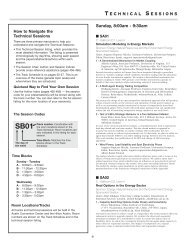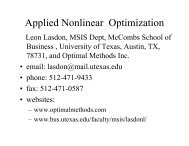Sunday
Sunday
Sunday
Create successful ePaper yourself
Turn your PDF publications into a flip-book with our unique Google optimized e-Paper software.
SB31<br />
2 - The Impact of Cost and Quality on Illegal Goods in the<br />
Supply Chain<br />
Maqbool Dada, Professor, Johns Hopkins Carey Business School,<br />
100 International Drive, Baltimore, MD, 21202, United States of<br />
America, dada@jhu.edu, Arkadi Seidscher, Stefan Minner<br />
A manufacturer of a branded product may deter competition from parallel<br />
imports, smuggled goods or counterfeits by investing in higher quality and<br />
lowering price. A four stage model of competition is developed to examine the<br />
impact of such competition. The analysis also has implications for legal means of<br />
competition; for example, from store brands in supermarkets or generic drugs in<br />
pharmacies.<br />
3 - How To (and How Not To) Manage Supplier’s Process<br />
Improvement: Delegation, Incentives, or Audit<br />
Mehmet Gumus, Assistant Professor, McGill University,<br />
1001 Sherbrooke West, Montreal, QC, H3A1G5, Canada,<br />
mehmet.gumus@mcgill.ca, Mohammad Nikoofal<br />
In this paper, we explore the effectiveness of process improvement as a supply<br />
disruption mitigation strategy in the presence of moral hazard and adverse<br />
selection. In order to address these issues, we develop a dyadic supply chain<br />
model where both the degree of supply disruption risk and supplier’s mitigation<br />
effort are unobservable from retailer. Our analysis shows that eliminating moral<br />
hazard via monitoring has a non-monotonic effect on the screening cost.<br />
4 - Intermediated Sourcing under Supply Disruption Risk<br />
Zhibin (Ben) Yang, Assistant Professor, University of Oregon, 1208<br />
University of Oregon, Eugene, 97403, United States of America,<br />
zyang@uoregon.edu, Volodymyr Babich<br />
We analyze a model where multiple buyers decide whether to procure goods from<br />
unreliable suppliers directly or using an intermediary firm. We show that lowrevenue<br />
buyers may enjoy spill-over benefits of procurement cost reduction<br />
when high-revenue buyers choose to use the intermediary. Intermediation may<br />
also reduce system-wide product waste, by coordinating diversification efforts<br />
across buyers. These benefits have to be weighed against intermediation costs,<br />
such as double-marginalization.<br />
■ SB31<br />
31- North 222 C- CC<br />
Supply Chain Risk and Resilience<br />
Cluster: Managing Disruptions in Supply Chains<br />
Invited Session<br />
Chair: Kash Barker, Assistant Professor, School of Industrial and<br />
Systems Engineering, University of Oklahoma, 202 W. Boyd St., Rm<br />
124, Norman, OK, 73019, United States of America,<br />
kashbarker@ou.edu<br />
1 - Disruption Management during Supply Chain Disruptions<br />
Cameron MacKenzie, University of Oklahoma, 202 W. Boyd St.,<br />
Norman, OK, United States of America, cmackenzie@ou.edu,<br />
Kash Barker<br />
Many firms suffered from supply disruptions due to the recent Japanese<br />
earthquake and tsunami. We analyze these disruptions by developing a model in<br />
which several suppliers’ production facilities are rendered inoperable. Each<br />
supplier must decide whether to move production to an alternate facility or wait<br />
for its facility to reopen. If suppliers do not produce at alternate facilities, firms<br />
will need to decide how to mitigate the impacts of a supply shortage.<br />
2 - Resilient Supply-chain Network Design with Multi-sourcing<br />
Haifei Yu, PhD, Northeastern University, No.11, Lane 3,<br />
WenHua Road, Heping District,Liaoning, Shenyang, 110004,<br />
China, hfyu@mail.neu.edu.cn, Shoufeng Ji<br />
With the uncertainty risk of supply disruptions, it is critical for the supply-chain<br />
system to be resilient. We study the problem of designing a resilient supply chain<br />
network with multi-sourcing, and propose a chance-constrained programming<br />
model, and use a mixed integer linear programming to solve it. We evaluate the<br />
benefit of multi-sourcing, balance operation costs, resilience, and disruption risk<br />
by the computational experiments.<br />
3 - Prediction and Prevention of Disruptions in Supply<br />
Chain Networks<br />
Xin Chen, Assistant Professor, Southern Illinois University<br />
Edwardsville, 3079 Engineering Building, Edwardsville, IL,<br />
62026-1805, United States of America, xchen@siue.edu<br />
The objective of this research is to apply the failure mode, effects, and criticality<br />
analysis (FMECA) and graph theory to predict and prevent disruptions in supply<br />
chain networks. A network may be disrupted due to node failures. A node<br />
represents a supplier, customer, or transportation route. This research applies<br />
graph theory to model supply chain networks and uses the FMECA to identify<br />
critical nodes. A case study of a construction supply chain is analyzed to validate<br />
the methodology.<br />
INFORMS Phoenix – 2012<br />
90<br />
4 - Supply Chain Resilience<br />
Ivan Hernandez, Stevens Institute of Technology, 167 8th Street,<br />
Apt 4, Hoboken, NJ, 07030, United States of America,<br />
ihernand@stevens.edu, Jose Ramirez-Marquez, David Nowicki<br />
We present a method that allows decision makers to ensure a Supply Chain (SC)<br />
returns to a high level of performance following a contingency. We introduce the<br />
concept of SC resilience as a function of the post-event investment resources<br />
needed for the SC to “bounce back”. The concepts can be used as a guide for<br />
companies to use their long-term SC plan as a starting point, then begin to ask<br />
themselves what they would do if various contingencies occur.<br />
■ SB32<br />
32- North 223- CC<br />
Assembly Line Design and Balancing I<br />
Contributed Session<br />
Chair: Slim Daoud, Université de Technologie de Troyes,<br />
32 Rue du Palais de Justice, Troyes, 10000, France, slim.daoud@utt.fr<br />
1 - Spreadsheet Based Optimization for Cell Formation Problem<br />
Gurkan Ozturk, Assistant Professor, Anadolu University, Faculty of<br />
Engineering, Department of Industrial Eng., Eskisehir, 26555,<br />
Turkey, gurkan.o@anadolu.edu.tr, Mumin Sonmez<br />
In this study, a new hybrid algorithm based on competitive neural network and<br />
particle swarm optimization approaches is proposed to solve cell formation<br />
problem with alternative part routings. This algorithm is implemented in two<br />
spreadsheet platform: MS Excel and Google Spreadsheet. Although MS Excel<br />
faster than the Google Spreadsheet, the property of internet access of google<br />
spreadsheet presents different advantages.<br />
2 - Neuro-fuzzy-genetic Algorithm for the Robotic Assembly<br />
Lines Balancing<br />
Slim Daoud, Université de Technologie de Troyes, 32 Rue du Palais<br />
de Justice, Troyes, 10000, France, slim.daoud@utt.fr, Yalaoui<br />
Farouk, Amodeo Lionel, Chehade Hicham, Duperray Philippe<br />
We are interested in an industrial application of a robotic assembly line problem.<br />
It consists of seizing the products on a moving conveyor and placing them on<br />
different deposit points. The goal is to optimize the efficiency of the line. As in our<br />
industrial application we are bounded by the execution time, we suggest a genetic<br />
algorithm combined with a neuro-fuzzy network to solve our problem. The<br />
experimental results show the advantages and the efficiency of the developed<br />
method.<br />
3 - Balancing Mixed Model Assembly Line with Capacity Buffer<br />
Jinlin Li, Xi’an Jiaotong University, No.28, Xianning West Road,<br />
Xi’an, China, ljl1019@163.com, Jie Gao, Linyan Sun<br />
This paper investigate the design of a mixed model assembly line with capacity<br />
buffer to satisfy unstable demands. The objective is to minimize the expected<br />
labor cost, including cost for normal operation and overtime work. A mathematic<br />
model is built and a method is proposed to estimate the cost lower bound. A<br />
branch, bound and remember algorithm is developed and the numerical<br />
experiment shows that the algorithm is effective and efficient.<br />
4 - Recognition of Freeform Surface Sheet Metal Features<br />
Saied Darwish, Professor, King Saud University, Riyadah,<br />
800/11421, Saudi Arabia, darwish@ksu.edu.sa,<br />
Hammouda Mousal<br />
This paper describes the design and implementation of a system for automated<br />
feature recognition of freeform surface CAD models of stamped and notched<br />
sheet metal parts, represented in STEP AP203 format through CATIA V5.



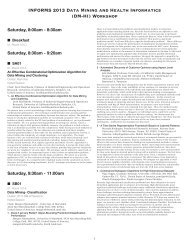
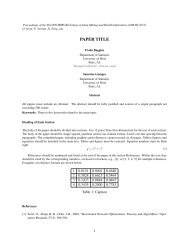
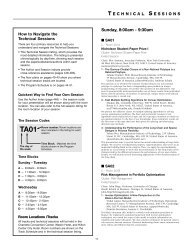
![[PDF] Charlotte Back Matter](https://img.yumpu.com/17933057/1/190x245/pdf-charlotte-back-matter.jpg?quality=85)

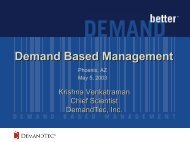
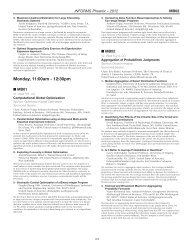
![[PDF] ALIO Back Matter](https://img.yumpu.com/17932960/1/190x245/pdf-alio-back-matter.jpg?quality=85)
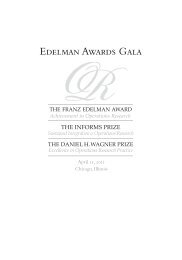
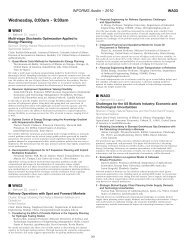
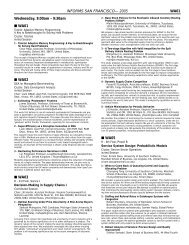
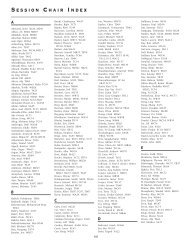
![[PDF] Monday, 8:00am - 9:30am](https://img.yumpu.com/17932954/1/190x245/pdf-monday-800am-930am.jpg?quality=85)
